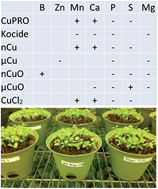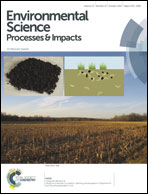Copper nanoparticles/compounds impact agronomic and physiological parameters in cilantro (Coriandrum sativum)
Abstract
The environmental impacts of Cu-based nanoparticles (NPs) are not well understood. In this study, cilantro (Coriandrum sativum) was germinated and grown in commercial potting mix soil amended with Cu(OH)2 (Kocide and CuPRO), nano-copper (nCu), micro-copper (μCu), nano-copper oxide (nCuO), micro-copper oxide (μCuO) and ionic Cu (CuCl2) at either 20 or 80 mg Cu per kg. In addition to seed germination and plant elongation, relative chlorophyll content and micro and macroelement concentrations were determined. At both concentrations, only nCuO, μCuO, and ionic Cu, showed statistically significant reductions in germination. Although compared with control, the relative germination was reduced by ∼50% with nCuO at both concentrations, and by ∼40% with μCuO, also at both concentrations, the difference among compounds was not statistically significant. Exposure to μCuO at both concentrations and nCu at 80 mg kg−1 significantly reduced (p ≤ 0.05) shoot elongation by 11% and 12.4%, respectively, compared with control. Only μCuO at 20 mg kg−1 significantly reduced (26%) the relative chlorophyll content, compared with control. None of the treatments increased root Cu, but all of them, except μCuO at 20 mg kg−1, significantly increased shoot Cu (p ≤ 0.05). Micro and macro elements B, Zn, Mn, Ca, Mg, P, and S were significantly reduced in shoots (p ≤ 0.05). Similar results were observed in roots. These results showed that Cu-based NPs/compounds depress nutrient element accumulation in cilantro, which could impact human nutrition.


 Please wait while we load your content...
Please wait while we load your content...